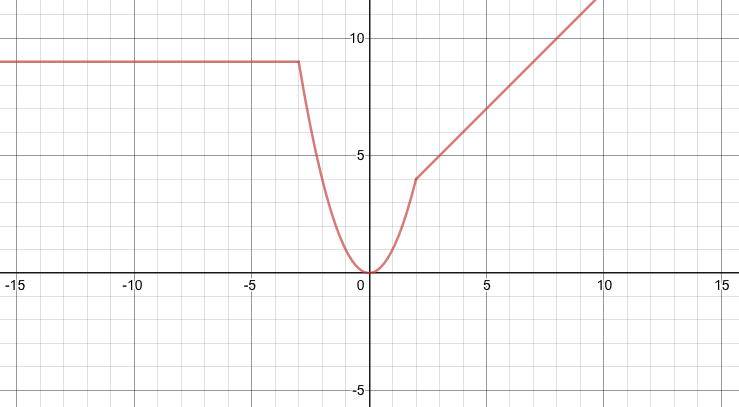For a certain value of r, the system
x + y + 3z = 10,
-4x + 2y + 5z = 7,
rx + z = 3
has no solutions. What is this value of r?
There is no solution, if the determinant \(\begin{vmatrix} 1&1&3\\-4&2&5\\r&0&1\end{vmatrix} = 0 \)
\(\begin{array}{|rcll|} \hline \begin{vmatrix} 1&1&3\\-4&2&5\\r&0&1\end{vmatrix} &=& 0 \\ 1\cdot2\cdot1+r\cdot1\cdot5+(-4)\cdot0\cdot3-r\cdot2\cdot3-(-4)\cdot1\cdot1-1\cdot5\cdot0 &=& 0 \\ 2+5r+0-6r+4-0&=& 0 \\ 6-r &=& 0 \\ \mathbf{r} &=& \mathbf{6} \\ \hline \end{array} \)
answer see also: https://web2.0calc.com/questions/for-a-certain-value-of-nbsp-k-nbsp-the-system_1
![]()
We put one open curly brace beside the "pieces" of the piecewise function, for example:
\(f(x)=\begin{cases} x+2 & \text{if}&x> 2 \\ x^2 &\text{if}& -3< x\leq 2 \\ 9 &\text{if}& x\leq-3 \end{cases}\)
This is the way to show the pieces of a piecewise function.
On the other hand, domains and ranges (and, of course, intervals) can be expressed in interval notation.
An interval is a set of values or numbers - not a set of expressions or functions.
E.g., the interval [0, 5) is every number between 0 and 5, including 0 and excluding 5.
And by looking at the graph for this function:

We can see:
| The domain is: | _ | (-∞, ∞) | ||
| The range is: |
| [0, ∞) | ||
| The intervals of decrease are: | (-3, 0) | ← | This means the function is decreasing for all x values in the interval (-3, 0) For instance, when x = -1, the function is decreasing. | |
| The intervals of increase are: |
| (0, 2) and (2, ∞) |
All of those are intervals expressed in interval notation.
(At the points where x = 2 and x = -3 , the slope is undefined, and so the function is neither increasing nor decreasing, and so we do not include those values in the intervals of increase or decrease.)
If the graph passes the vertical line test, then it is a function.
Here are a bunch of examples: https://imgur.com/a/Px4lYIt
(If you still are wondering about whether a particular situation is considered a function or not, you could try to draw it on desmos and share the graph or draw it on a piece of paper and take a photo.)
Also, you might want to read the first paragraph of this page: https://en.wikipedia.org/wiki/Interval_(mathematics)
Hope this helps somewhat! If you're confused about something, please say so! ![]()